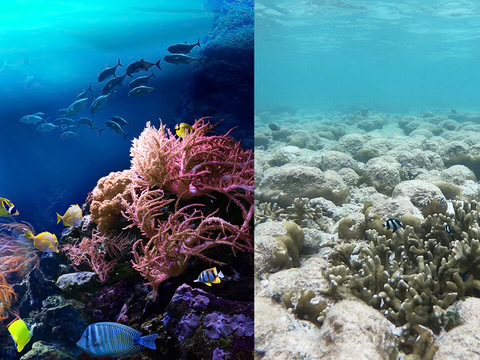By Jamila Talishli, Year 12.
As summer gets closer and the days grow longer, the sun is finally making an appearance- and with it comes the need to put on sunscreen. Whether you’re going for a walk, trying to get a tan at the beach, or even sitting in class by a sunny window, protecting your skin from harmful UV rays is essential. It can prevent sunburn, premature aging, and most importantly, reduces the risk of skin cancer. While sunscreen protects us, we can’t help but wonder- does it protect the planet too? As we become increasingly aware of environmental issues, the plastic packaging sunscreen comes in and the harmful effects some ingredients have on coral reefs and marine life are becoming important concerns regarding sunscreen’s environmental impact.
One of the most visible sustainability concerns with sunscreen is its plastic packaging. Every summer, countless sunscreen bottles, tubes, and cans are used up and then thrown away, just to be replaced with new ones- the cycle never ends. This contributes significantly to plastic waste, as these empty containers usually end up in landfills or oceans, where they can take hundreds of years to decompose. Another issue is that sunscreen packaging is usually made up of multi-layered plastics, which are very difficult to recycle.
Additionally, this plastic packaging allows the presence of microplastics in some sunscreens. These tiny plastic particles can enter waterways after use and harm marine ecosystems, but are also quite toxic for the skin. These plastics are not filtered out in water due to their size, and their persistence in the environment causes risks to aquatic and human health.
One way to address this issue is by finding alternatives to plastic packaging- brands are exploring different options, like aluminum or glass containers, which are fully recyclable and can even be reused. Biodegradable materials, such as plant-based plastic or paper-based tubes are also an option, as they break down over a shorter period of time. One other way to reduce waste is through refillable packaging, encouraging consumers to reuse their containers, which significantly cuts down on waste. All of these options can pave the way for a more sustainable future in sun protection.
The environmental impact of sunscreen extends beyond its packaging- most sunscreens contain certain chemical ingredients which pose a significant threat to marine ecosystems. The UV filters in chemical sunscreens, like oxybenzone and octinoxate, have been linked to coral reef degradation. These chemicals can damage coral DNA, disrupt their reproduction and weaken their resilience to environmental stressors. Studies have found that even a tiny amount of these chemicals entering water bodies can cause huge damage to corals, and the impact is huge- especially in popular snorkeling and diving destinations. In response to this, Palau became the first nation to ban chemical sunscreens in 2020, and Hawaii followed in with a 2021 ban.
A more coral reef friendly alternative is mineral sunscreen, which uses zinc oxide or titanium dioxide as active ingredients to protect from UV rays. Unlike chemical sunscreens, which are absorbed into the skin, mineral sunscreens act as a physical barrier, sitting on the skin’s surface to block UV rays. These ingredients are less harmful to marine life as they break down naturally without releasing toxic chemicals, and provide effective sun protection while minimizing environmental damage.
As awareness grows about the environmental consequences of sunscreen, it becomes increasingly clear that protecting our skin shouldn’t come at the expense of damaging our planet. Although sunscreen is essential to protect our skin from harmful UV rays, the cycle of disposable packaging and toxic chemical filters poses a huge threat to the marine ecosystem. However, many solutions exist: sustainable packaging alternatives like refillable containers and reef-safe mineral sunscreens significantly reduce waste and harm, allowing us to enjoy the sun responsibly.



